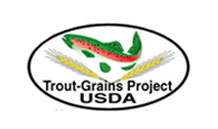
USDA - ARS
Trout-Grains Project
Trout-Grains Project
Project PlanMS Word 8.28MB
This project uses parallel, interconnected lines of research to improve the sustainability and production efficiency of rainbow trout (Figure 1). Alternative ingredients from multiple sources will be used directly, developed, or modified in order to eliminate or reduce fish meal and oil in trout diets. Concurrently, trout populations will be screened to identify variation in important traits and to identify genes specific to the utilization of these feeds and to elucidate the genetic basis for improvement. A series of digestibility trials will be performed to define available nutrient levels from currently available and enhanced plant products. Supplementation needs for specific amino acids and minerals in fish meal-free feeds will be determined. Biochemical, physiological and genetic responses of fish fed alternative diets will be determined using genetic and physiological tools. Carbohydrates and fatty acids in grains differ in both type and abundance from fish meal and oil, and understanding the metabolic and genetic factors affecting nutrient utilization of trout will improve selection efforts in both trout and grains, and increase the precision of nutrient supplements, thereby reducing excretory waste. The anticipated outcomes from the project are: 1) improved feeds for fish farmers, environmental compliance through reduced nutrient release, identified traits and markers to aid stock improvement efforts 2) alternate ingredients, reduced costs, price stability, and improved diet formulations for feed manufacturers; 3) new markets and products for grain farmers; and 4) a safe, sustainable, nutritious food supply and cleaner environment for U.S. consumers.
The overall goal of this project is to improve the sustainability and production efficiency of rainbow trout by developing innovative feeds that reduce dependence on marine fishery resources. This will be accomplished through the integrated development of improved ingredients and feeds and elucidation of the molecular mechanisms underlying metabolic processing of these ingredients (Figure 1).
The specific objectives are:
Objective 1: Identify and develop grain lines with desirable traits for either direct or indirect use in aquafeeds.
Objective 2: Develop mechanical, chemical and biological methods to improve the nutritional and anti-nutritional profile of grains, by-products and other alternative ingredients.
Objective 3: Determine nutritional value of alternative ingredients (protein, lipid, energy) and develop practical feed formulations for improved strains of fish.
Objective 4: Determine optimal nutrient supplementation levels for specific life stages of improved strains of trout.
Objective 5: Use gene expression analyses to advance the understanding of gene targets for improving nutrition, growth, and development processes under production conditions.
Objective 6: Identify phenotypic differences in rainbow trout for growth and utilization of plant-based sustainable diets and determine the genetic variation for the identified traits.

